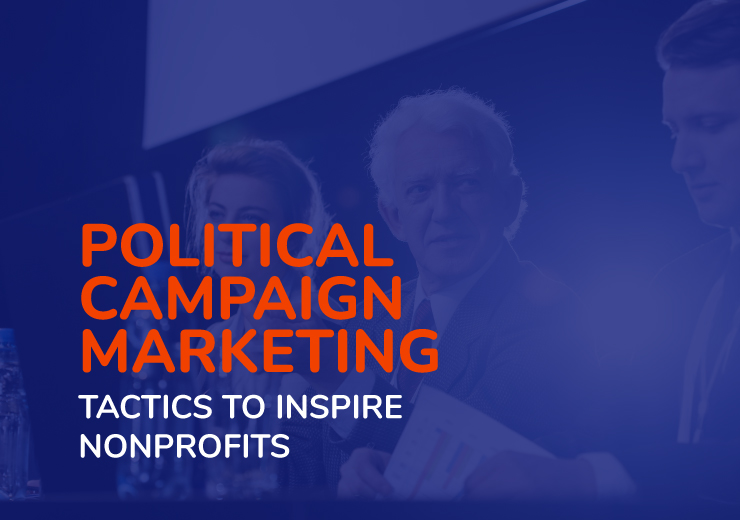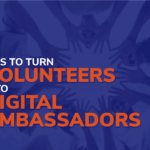3 Political Campaign Marketing Tactics to Inspire Nonprofits

During election years, everyone’s minds are on politics. The closer you get to Election Day, the more signs, advertisements, and news you see about the candidates running for office. It can sometimes feel overwhelming, but political campaigns are undeniably good at getting attention. As a nonprofit, you might wonder how you can emulate political campaign marketing strategies and success.
While there are many differences between the ways nonprofits and political campaigns operate, their core marketing goals are the same — to reach a wide audience and gain their support. Let’s zero in on three impactful political marketing strategies you can apply to your own campaigns, whether you’re looking to recruit volunteers, acquire new supporters, or engage current donors.
1. Text Banking
By this point, almost every American has received at least one text from a political campaign. This is thanks to a practice called text banking.
Text banks are targeted efforts in which political campaigns message large numbers of voters or supporters via text. Political campaigns use text banking for various strategic efforts, including voter outreach, fundraising, volunteer communication, polls and surveys, and event marketing. Text banking works because text messages are extremely versatile and come with the following benefits:
-
High open rates: While 98% open rates are uncommon among other communication channels, they’re the norm for SMS.
-
Quick response times: Texts have the unique ability to grab supporters’ attention, prompting quick actions and responses from audience members.
-
Easy two-way conversation: The convenience and speed of texting a campaign (or nonprofit) back opens the door for valuable conversations and relationship-building opportunities.
Political campaigns often use political texting software to enable volunteers to take the lead in initiating and managing text conversations. With these tools, volunteers can easily access scripts, see contact lists, and automatically record voter or donor information.
Nonprofit Inspiration: Text Marketing
Many CRMs and online fundraising tools come equipped with text marketing features, enabling you to automate SMS campaigns and add donors’ responses directly to their profiles in your database.
To get started with text marketing, you must first understand the rules about opt-ins and opt-outs. Nonprofit SMS regulations aren’t as strict as the ones governing businesses, but you still must have recipients’ consent before texting them. You can collect opt-ins by:
-
Adding a phone number field and the option to receive text communications to your online donation form.
-
Sending an email promoting text opt-in.
-
Sharing an opt-in keyword (like “JOIN”) and phone number on social media and event flyers.
-
Add an on-page text opt-in form to the footer of your website.
For extra security, consider setting up a double opt-in process. After receiving an opt-in via a form or keyword submission, send a message like, “Thanks for subscribing to [Organization]’s texts. Text YES to opt-in or STOP to opt-out.” This way, your nonprofit gets a second verification of consent, and the supporter knows how to unsubscribe at any time.
Once you can collect opt-ins, start incorporating texts into your broader marketing strategy. Lean into the channel’s strengths by encouraging supporters to respond directly, sending urgent fundraising appeals, and leveraging texts for easy feedback collection.
2. Public Endorsements
Endorsements can make a major difference in contentious races. If a candidate gets publicly endorsed by an influential community leader, a union or professional association, or another relevant politician, they may win the support of many voters who were on the fence. This is especially true if the endorsement comes from someone of the opposite party or a candidate who previously ran against them.
To secure an endorsement, a political campaign must first research the potential endorser and build a positive relationship with them. While some endorsements come unsolicited, political candidates typically make an explicit ask and explain how the endorsement will benefit everyone involved.
Nonprofit Inspiration: Influencer Marketing
Formalized endorsements may seem like a practice confined to the political realm, but they tap into a core marketing tenant that nonprofits should follow: using the power of social proof.
Social proof is a powerful motivator for voters, customers, and donors alike. When prospective donors see that your nonprofit comes highly recommended by someone they trust (whether that’s a friend, family member, or their favorite social media influencer), they’re more likely to believe in your nonprofit’s value and offer their support.
Similar to political endorsements, your nonprofit can harness the potential benefits of social proof by getting “endorsed” by influencers. By partnering with a nonprofit influencer and asking them to promote your organization to their social media followers, you’ll gain access to a brand-new audience and prove to them that your organization is trustworthy.
3. Ad Targeting
Another impactful way that political campaigns access new audiences is through a process called ad or audience targeting. This type of political advertising uses existing audience data to target similar groups that may be interested in supporting a campaign. It’s often done on social media, but campaigns might also use audience targeting for other online advertisements like banner or display ads.
Here’s a quick breakdown of how political ad targeting works using social media:
-
A campaign pulls lists of target voters or donors from its database.
-
They use audience targeting tools (like Facebook Ad Manager or political marketing software) to choose whether they want to hone in on a lookalike audience or a custom audience.
-
The campaign tailors its request by choosing a location and/or specific characteristics they’re looking for.
-
The social media platform shows the campaign’s ads to users with similar attributes to the campaign’s existing audience.
Using this process, political campaigns can easily get their ads in front of brand-new voters and potential donors.
Nonprofit Inspiration: Search Ads
Investing in ad targeting may be feasible for larger nonprofits with plenty of room in their marketing budgets, but it’s out of reach for many organizations. Fortunately, there’s a more accessible option that uses similar principles to unlock new audiences.
Search ads are sponsored search results that appear at the top and bottom of Google’s search results pages for relevant queries. For instance, if you search “Italian places near me,” you might see advertisements for Olive Garden and a few local Italian restaurants. Since search ads appear based on relevance, you’re guaranteed to reach audiences that are predisposed to being interested in your content.
And best of all, eligible nonprofits can access this opportunity for free. All you have to do is follow a few steps:
-
Optimize your website for user-friendliness, accessibility, and helpful content.
-
Apply for the Google Ad Grant, which grants eligible organizations $10,000 worth of free ad credits per month.
-
Once approved, start creating ads for specific pages on your site, such as event landing pages or a program sign-up page.
-
Choose and bid on keywords that your target audience might search for. For instance, an animal rescue might bid on “puppies for adoption,” “adopt a cat,” and “foster programs near me.”
-
Track ad conversions and adjust your ads and keyword strategies accordingly.
Though the program is free, it can be time-consuming to create multiple advertisements, monitor conversions, and pivot your keyword strategy to focus on the most effective search queries. Before committing to the program, make sure you have enough staff time and expertise (or the capacity to hire a Google Ads manager).
When you run low on ideas, it’s helpful to look to other industries and see how they approach marketing differently. By implementing these strategies inspired by political campaigns, you can branch out with your marketing tactics and reach new audiences in compelling, innovative ways.


